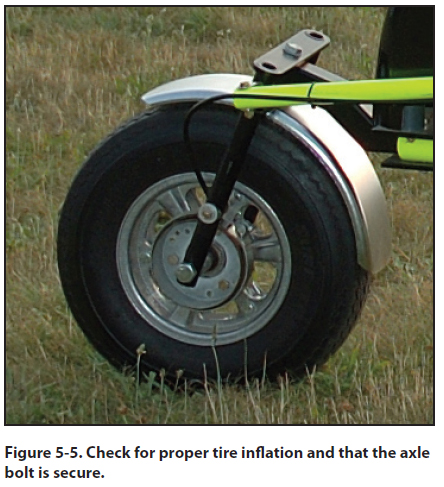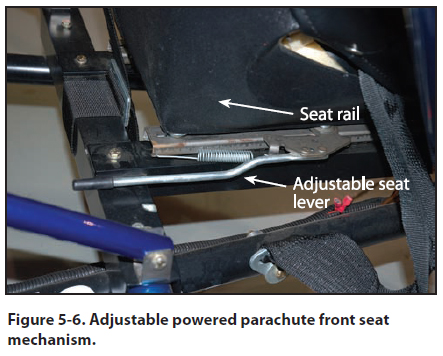|
Chapter 5 — Preflight and Ground Operations
Visual Inspection
The accomplishment of a safe flight begins with a
careful visual inspection, regardless of the category/
class of aircraft you will be flying. The purpose of the
routine preflight inspection is twofold: to determine
the powered parachute is legally airworthy, and that it
is in condition for safe flight. You determine whether
the PPC is in a condition for safe flight by a thorough
and systematic preflight inspection of the aircraft
and its components. The preflight inspection should
be performed in accordance with a printed checklist
provided by the powered parachute manufacturer for
the specific make and model of aircraft. However, the
following general areas are applicable to all powered
parachutes.
The preflight inspection should begin as soon as
you approach the aircraft. Since the powered parachute
can be transported by trailer, the unloading of
the aircraft allows you extra opportunity to look the
cart over from front to back and top to bottom. First
and foremost, you need to look for any damage that
may have occurred during transit. Make note of the
general appearance of the aircraft, looking for obvious
discrepancies such as tires with low air pressure,
structural distortion, wear points, cart damage, and
dripping fuel or oil leaks. All tie-downs, control locks,
and chocks should be removed during the unloading
process.
It is absolutely necessary you are thoroughly familiar
with the locations and functions of the aircraft systems,
switches, and controls. Use the preflight inspection
as an orientation when operating a make/model
for the first time.
The actual “walk around” is a routine preflight inspection
and has been used for years from the smallest
general aviation airplane to the largest commercial
jet. The walk around is thorough and systematic, and
should be done the same way each and every time an
aircraft will be flown. In addition to “seeing” what
you’re looking at, it requires you take the appropriate
action whenever a discrepancy is discovered. A
powered parachute walk around will cover five main
tasks:
1. Cart inspection
2. Powerplant inspection
3. Equipment check
4. Engine warm-up and check
5. Wing and suspension line inspection
Each PPC should have a specific routine preflight inspection
checklist, but the following can be used as a
guideline for most PPCs.
Cart Inspection
Check the front nosewheel for proper play, tire inflation,
and secure axle bolt. Test the ground steering bar
connection points and ensure there is smooth steering
range of motion from the steering bar. Check and secure
the connections between the front fork and the
front axle and the front fork and the gooseneck. [Figure
5-5]

When brakes are installed, it is common for them to
be on the front nosewheel. Typically, they are drum
or disk style operated by a cable; it is important to
inspect the cable lock, assuring it is tight. The brakes
may be hydraulic disk brakes that also incorporate a
cable; in this case, inspect both components. Check
brakes and brake systems for rust and corrosion, loose
nuts/bolts, alignment, brake pad wear/cracks, signs of
hydraulic fluid leakage, and hydraulic line security/
abrasion.
Inside the cart where the pilot sits, check the seats,
seat rails, and seat belt attachment points for wear,
cracks, and serviceability. A few manufacturers offer
powered parachutes with adjustable front seats. The
lever moves the pin in and out of the seat rail holes
and the seat then moves forward and back along the
rail. The seat rail holes should be checked for wear;
they should be round and not oval so there is no play in the fixed position of the pilot seat. Inspect where
the seat lock pins fit; check the pin and seat rail grips
for wear and serviceability. [Figure 5-6]

The battery and ignition switches need to be in the
OFF position at the beginning of the preflight inspection.
They will be turned on and then off again
to check the different components operated by the
power source during the preflight. While checking the
ignition switches, check that the strobe is operational
if one is installed. Exercise the primer or primer bulb,
if the PPC is so equipped; you should feel resistance
when exercised. Faulty primers can interfere with
proper engine operation.
Manipulate the engine throttle control by slowly
moving through its full range of motion to check for
binding or stiffness. On two-stroke engines with oil
injection, it is important to check that the oil injection
mechanism is moving freely. [Figure 5-7]

Set the altimeter to the field elevation or set in the
barometric pressure, if equipped. Turn on the ignition
or engine instrument system master and make note
of the fuel quantity gauge indications, if applicable,
for comparison with an actual visual inspection of the
fuel tank(s) during the exterior inspection.
Inspect for any signs of deterioration, distortion, and
loose or missing bolts or locknuts. Gently shake the
cart to determine if objects and airframe parts are
loose and need to be tightened. Treat all aircraft and
their components with respect and care while conducting
a preflight. As with all aircraft, the PPC does
not need to be “over-handled” to perform an adequate
preflight inspection. Check that all cables are free of
kinks, frays, abrasions or broken strands; check each
end of each flying cable for bolt security and check
that the thimbles are not twisted or elongated.
Check the steering bars for freedom of movement,
for proper steering line attachments, and confirm the
steering bars are securely attached.
Inspect the rear wheel and axle assembly. Check the
tires for proper inflation, as well as cuts, bruises, wear,
bulges, imbedded foreign objects, and deterioration.
As a general rule, tires with cord showing, and those
with cracked sidewalls are unairworthy. Check the
axle and axle hardware, and inspect that the wheels
rotate properly.
|

